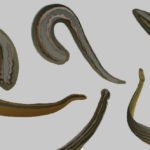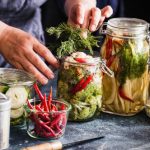 Movies and TV
Movies and TV  Movies and TV
Movies and TV  History
History 10 Things You Never Knew About Presidential First Ladies
 Movies and TV
Movies and TV 10 Zombie Movies That Will Actually Terrify You
 Humans
Humans 10 Times Scientists Were Absolutely Sure… and Absolutely Wrong
 Our World
Our World 10 Pivotal Moments for Life on Earth
 Movies and TV
Movies and TV 10 Most Realistic Medical TV Shows of All Time
 Creepy
Creepy 10 Eerie & Mysterious Ghosts of the Pacific Coast
 Weird Stuff
Weird Stuff 10 Typos That Accidentally Changed History
 History
History 10 Times Trickery Won Battles
 Technology
Technology 10 Awesome Upgrades to Common Household Items
 Movies and TV
Movies and TV 10 Movie Flops That Found Their Way to Cult Classic Status
 History
History 10 Things You Never Knew About Presidential First Ladies
 Movies and TV
Movies and TV 10 Zombie Movies That Will Actually Terrify You
Who's Behind Listverse?

Jamie Frater
Head Editor
Jamie founded Listverse due to an insatiable desire to share fascinating, obscure, and bizarre facts. He has been a guest speaker on numerous national radio and television stations and is a five time published author.
More About Us Humans
Humans 10 Times Scientists Were Absolutely Sure… and Absolutely Wrong
 Our World
Our World 10 Pivotal Moments for Life on Earth
 Movies and TV
Movies and TV 10 Most Realistic Medical TV Shows of All Time
 Creepy
Creepy 10 Eerie & Mysterious Ghosts of the Pacific Coast
 Weird Stuff
Weird Stuff 10 Typos That Accidentally Changed History
 History
History 10 Times Trickery Won Battles
 Technology
Technology 10 Awesome Upgrades to Common Household Items
Top 10 Worst Alternative Health Practices Influencers Pedal
In wellness and self-care, the landscape of alternative health practices is diverse and controversial. Amid the genuinely beneficial approaches, there exists a darker underbelly of ineffective and potentially harmful practices. Here, we delve into the top 10 worst alternative health practices influencers often promote, shedding light on the facts and fiction behind each one.
Related: Top 10 Health Disorders Made Up To Sell Products
10 Crystal Healing
Crystals have fascinated humans for centuries, but their alleged healing powers have been greatly exaggerated. Influencers champion the idea that different crystals can align your chakras, boost your energy, and even alleviate ailments. However, the scientific community widely challenges these claims due to a lack of empirical evidence.
While crystals possess unique mineral compositions, there’s no concrete proof that they emit energies capable of affecting our bodies or minds. Despite the allure of their vibrant colors and intricate formations, relying solely on crystals for health benefits is akin to placing one’s faith in magic.
-
Amethyst for Stress Relief: Advocates of crystal healing might suggest using amethyst to alleviate stress and promote relaxation. It’s believed that this purple crystal can help calm the mind and provide a sense of tranquility.
-
Rose Quartz for Love and Relationships: Rose quartz is often associated with love and emotional healing. Crystal healing proponents might recommend using rose quartz to attract love, enhance relationships, and foster self-love.
-
Citrine for Abundance: Citrine is thought to be a crystal of abundance and prosperity. Those who practice crystal healing might use citrine to manifest wealth, success, and positive energy.
9 Ear Candling
Sticking a cone-shaped candle into your ear to draw out wax and toxins might seem bizarrely intriguing, but it’s far from effective. Ear candling has gained popularity due to influencers touting its cleansing properties. However, medical experts caution against this practice, as it’s known to cause burns, ear canal obstructions, and even serious injuries such as punctured eardrums.
Research reveals that the debris found within the “candled” residue isn’t actually earwax but remnants of the candle wax itself. The purported benefits are nothing more than a placebo effect, leaving this practice more hazardous than helpful.
-
Ear Wax Removal: One of the supposed benefits of ear candling is the removal of excess ear wax. Proponents believe that the heat generated by the candle creates a vacuum that draws out earwax and other debris from the ear canal.
-
Sinus Congestion Relief: Some ear candling enthusiasts claim that the practice can help alleviate sinus congestion and pressure. It’s believed that the warmth and suction can promote better drainage and relieve discomfort.
-
Spiritual Cleansing: Besides physical benefits, some believe ear candling can have spiritual or energy-cleansing effects. The process is thought to remove negative energy and promote balance.
8 Detox Teas
Detox teas are marketed as a way to rid the body of toxins and shed pounds effortlessly. Influencers often share their “miraculous” weight loss journeys, attributing their success to these teas. However, these products often contain laxatives that lead to temporary weight loss through fluid loss, and their long-term effects are anything but healthy.
Our bodies are equipped with sophisticated detoxification systems, primarily the liver and kidneys, which work diligently to eliminate waste. Relying on detox teas can lead to dehydration, electrolyte imbalances, and a disruption in natural digestion processes.
-
Weight Loss Teas: Many detox teas are marketed as weight loss aids, claiming they can help boost metabolism and shed unwanted pounds. Herbal ingredients like green tea and dandelion root are often included for their potential diuretic effects.
-
Digestive Cleansing: Some detox teas are promoted as digestive aids, with ingredients like ginger and fennel purportedly helping to soothe digestive discomfort and improve gut health.
-
Liver Detoxification: Detox teas with ingredients like milk thistle and dandelion root are said to support the liver’s natural detoxification processes, although scientific evidence for these effects is limited.
7 Homeopathy
Homeopathy operates on the principle of extreme dilution, where substances are diluted to the point where hardly any molecules of the original substance remain. While followers swear by its effectiveness, scientific consensus points to the placebo effect as the primary source of perceived benefits.
Homeopathic remedies are so diluted that the final product often contains little to no trace of the original substance. In essence, consumers are paying for water or sugar pills. Despite its popularity, homeopathy remains a practice with minimal scientific backing.
-
Arnica Montana for Bruises: Arnica montana is a common homeopathic remedy used to treat bruises, muscle soreness, and swelling. Despite its popularity, scientific evidence supporting its efficacy remains inconclusive.
-
Ignatia for Grief: Ignatia is often recommended for emotional distress, including grief and sadness. Homeopaths believe it can help alleviate feelings of sorrow and emotional turmoil.
-
Rhus Toxicodendron for Joint Pain: Rhus toxicodendron, derived from poison ivy, is used in homeopathy to treat joint pain and stiffness that worsen with initial movement but improve with continued motion.
6 Oil Pulling
Oil pulling involves swishing oil around in your mouth to purportedly improve oral hygiene and overall health. Influencers highlight its ability to whiten teeth and remove toxins. However, dental experts assert that oil pulling should not replace traditional dental care practices like brushing and flossing.
While oil pulling might freshen your breath temporarily, its claimed benefits lack scientific support. Rather than relying on this practice alone, maintaining regular oral hygiene habits and seeking advice from dental professionals are more prudent paths to oral health.
-
Coconut Oil for Oral Health: Coconut oil is a popular choice for oil pulling due to its potential antimicrobial properties. Advocates claim that swishing coconut oil in the mouth can help remove harmful bacteria and improve oral hygiene.
-
Whitening Effect: Some proponents of oil pulling suggest that the practice can lead to whiter teeth and a brighter smile. This effect is often attributed to the oil’s ability to lift stains from the teeth.
-
Bad Breath Reduction: Oil pulling is also thought to combat bad breath by removing bacteria responsible for foul odors. By swishing oil in the mouth, advocates claim that a cleaner mouth can produce fresher breath.
5 Reiki
Reiki, a form of energy healing through touch, has gained traction among alternative health enthusiasts. Influencers often portray it as a way to balance energy fields and promote holistic wellness. Despite its popularity, scientific research has struggled to find consistent evidence supporting Reiki’s efficacy.
The concept of manipulating energy flows within the body lacks empirical grounding. Studies attempting to validate Reiki’s claims have faced challenges in methodology and replication, leading the scientific community to approach this practice with skepticism.
-
Energy Balancing: Reiki practitioners often claim the practice can balance and align the body’s energy fields, promoting physical, emotional, and spiritual well-being. It’s believed that the practitioner channels healing energy into the recipient’s body through touch or proximity.
-
Stress Reduction: Reiki is often touted as a stress-reduction technique. Advocates believe the gentle energy work can induce deep relaxation, which may help alleviate stress and anxiety.
-
Pain Relief: Some individuals turn to Reiki to manage pain, such as chronic pain conditions. Reiki enthusiasts believe the practice can help alleviate discomfort by addressing energetic imbalances within the body.
4 Cupping Therapy
Cupping therapy has garnered attention thanks to celebrities flaunting circular marks as a sign of the practice’s efficacy. Influencers and practitioners assert that cupping can alleviate pain, enhance blood flow, and promote healing. However, scientific consensus contradicts these claims.
Those characteristic marks left by cupping result from blood vessels breaking under the skin’s surface rather than a magical healing process. While some users report temporary relief, its effectiveness is likely tied to the placebo effect rather than any concrete physiological changes.
-
Muscle Pain Relief: Cupping therapy is frequently used to address muscle pain and tension. Practitioners place cups on specific body areas and create suction, which is believed to promote blood flow, reduce inflammation, and alleviate discomfort.
-
Detoxification: Some proponents claim that cupping therapy can aid detoxification by drawing toxins and impurities to the skin’s surface. The circular marks left by cupping are often interpreted as evidence of toxins being released.
-
Improved Circulation: Cupping is thought to enhance blood circulation, contributing to overall health and healing. The suction the cups create encourages blood flow and promotes the body’s natural healing processes.
3 Raw Water
Influencers have embraced the concept of raw water—unfiltered and untreated spring water—as a health elixir. However, health experts caution against consuming raw water due to potential contaminants, including harmful bacteria and parasites that can lead to serious illnesses.
While spring water might evoke feelings of purity, untreated water sources carry significant risks. Drinking raw water bypasses necessary treatment processes that eliminate potential hazards, making it a risky alternative to properly treated and purified tap water.
-
Natural Mineral Content: Advocates of raw water argue that it contains natural minerals and nutrients that can benefit health. They suggest untreated spring water can provide essential minerals that may be lacking in treated tap water.
-
Alleged Purity: Raw water enthusiasts often claim that untreated water from natural sources is pure and free from the additives and contaminants found in tap water. They believe consuming raw water is a way to connect with nature and maintain health.
-
Microbiome Support: Some proponents suggest that raw water contains beneficial microorganisms that can support the gut microbiome and overall immune system. They argue that the sterilization processes used in treating tap water eliminate these beneficial microbes.
2 Psychic Surgery
Promoted as a non-invasive alternative to traditional surgical procedures, psychic surgery claims to heal illnesses by removing them through a healer’s hands. Influencers and practitioners assert its effectiveness, but no credible scientific evidence supports this practice.
Psychic surgery operates on mystical premises rather than medical principles. Skeptics argue that any positive outcomes are likely due to the placebo effect or the power of suggestion rather than any actual medical intervention.
-
Non-Invasive Healing: Psychic surgery is promoted as a non-invasive alternative to traditional surgical procedures. Practitioners claim to use their hands to “remove” illnesses or negative energies from the body without making any incisions.
-
Energetic Clearing: Psychic surgery is often associated with energetic clearing or cleansing. Practitioners assert they can detect and eliminate energetic blockages or imbalances contributing to physical or emotional issues.
-
Holistic Healing: Proponents of psychic surgery believe it addresses physical ailments and emotional and spiritual concerns. The practice is said to promote holistic well-being by addressing the root causes of various health problems.
1 Breatharianism
The ultimate extreme in alternative health, breatharianism advocates living solely on air and sunlight without needing food or water. Influencers who promote this practice suggest that the body can thrive on prana (life force) alone. However, this notion is not only scientifically unfounded but also exceedingly dangerous.
Human bodies require nutrients and hydration for survival. Breatharianism poses severe health risks, leading to malnutrition, organ failure, and even death. The body’s physiological needs cannot be bypassed through wishful thinking or pseudoscientific claims.
-
Spiritual Enlightenment: Some proponents of breatharianism suggest that the practice can lead to spiritual enlightenment and higher consciousness. They argue that freeing oneself from the need for physical sustenance allows for deeper spiritual experiences.
-
Health and Longevity: Breatharians often assert that the practice can improve health and longevity. They believe reducing or eliminating food consumption can prevent diseases and promote a healthier body and mind.








